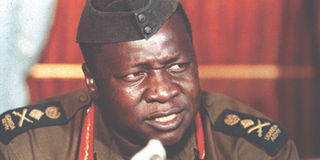Kenya, Uganda on brink of war

The late Ugandan dictator Idi Amin. His claim in 1976 that the whole of the former Western and Nyanza provinces and parts of the Rift Valley up to Naivasha belonged to Uganda put Kenya and Uganda on the brink of war. PHOTO|FILE
What you need to know:
- Amin argued he had a map and a written agreement signed by the British colonial secretary of state Herbert Asquith, transferring some parts of Uganda to Sudan in 1914 and to Kenya in 1926.
- In his words, “God was not a fool to have allocated this land to Uganda” and wondered why the British did not transfer other areas that were not fertile.
- His argument that these areas belonged to Uganda at one time was correct, but this had been overtaken by the subsequent redrawing of borders and the 1964 OAU undertaking.
Kenya massed its troops on the Ugandan border after its leader, Idi Amin, laid claim to a huge swathe of the country’s territory.
The area Amin claimed included the whole of the former Western and Nyanza provinces and parts of the Rift Valley up to Naivasha, some 80 kms from Nairobi.
Amin argued he had a map and a written agreement signed by the British colonial secretary of state Herbert Asquith, transferring some parts of Uganda to Sudan in 1914 and to Kenya in 1926.
These included Turkana, part of Lake Rudolf (now Lake Turkana), West Pokot, Trans-Nzoia, Bungoma, Busia, Kakamega, Central Nyanza, South Nyanza, Narok, Kisii, Kericho, Nakuru, Uasin Gishu, Elgeyo Marakwet, Nyandarua, Nandi, Kisumu, Eldoret, Tambach, Maji Moto, Maji Mazuri, Gilgil, Nakuru, Lake Baringo and Naivasha.
He also claimed part of the current Republic of South Sudan up to Torit, as he emphasised that the area belonged to Uganda prior to the Berlin Conference of 1884 that demarcated Africa among European powers.
He argued that East Africans knew their boundaries and that the British colonialists made several mistakes when they were making territorial demarcations because all ethnic groups had blood relations across borders.
In his words, “God was not a fool to have allocated this land to Uganda” and wondered why the British did not transfer other areas that were not fertile.
Amin only backed down after Jomo Kenyatta issued a stern warning that Kenya would not part with “a single inch of territory” and deployed troops and tanks along the Kenya–Uganda border.
Merely informing
All this time, Amin was maintaining that he was merely informing the people of Uganda without any intention for war or boundary changes.
At that time, Amin was the chairman of the defunct Organisation of African Unity (OAU), which in 1964 had passed a resolution that all member states pledge themselves to respect the borders existing on their attainment of independence.
Earlier in 1975, Amin had been involved in a series of provocative actions against Kenya.
Properties of Kenyan companies in Uganda were looted as Kenyans at Makerere University were expelled.
Others vanished without trace after being abducted by Amin’s agents.
In June 1975, Kenyan intelligence impounded a large convoy of Soviet-made arms en route to Uganda from Mombasa port.
Thus, the territorial claim was seen as the reason behind the arms import with the intention of declaring war on his neighbours.
Amin based part of his argument on the old 1920 map where the entire western Kenya region was in Uganda, and the Kingdom of Nabongo Mumia of Wanga extended from Naivasha to eastern Uganda.
Redrawing of borders
His argument that these areas belonged to Uganda at one time was correct, but this had been overtaken by the subsequent redrawing of borders and the 1964 OAU undertaking.
During the scramble and partition of Africa by imperial powers in Berlin in 1884, Uganda fell under British influence and was later divided into six provinces in 1902.
These were: Rudolf Province, which included the Turkana and Karasuk; Eastern Province, which included Nandi, Kavirondo, Eldoret, Naivasha, Maasai, up to the border with Tanzania; Central Province, which included Karamoja, Sebei, Mumias, Busoga and Bukedi.
Others were Buganda Province, which included Entebbe, Masaka, Kampala, Bugangaizi and Buruli; Nile Province, which included the whole of the present Nile Province, Lango, Acholi, Juba, and Baragazalo which is about 600 miles away from Kampala and Western Province, which included Rwenzori, Boga, Hoima and Masindi.
His claim on Kenya sparked street protests across the country.





